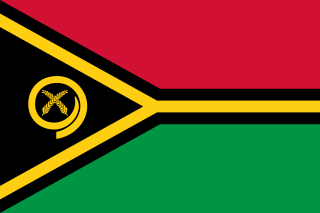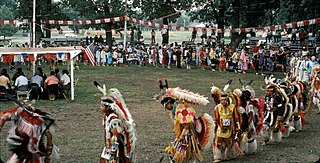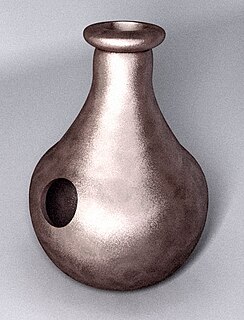
In Vanuatu, a slit drum is a musical instrument that is traditionally played by men of high rank. [1]

Vanuatu, officially the Republic of Vanuatu, is a Pacific island country located in the South Pacific Ocean. The archipelago, which is of volcanic origin, is 1,750 kilometres (1,090 mi) east of northern Australia, 540 kilometres (340 mi) northeast of New Caledonia, east of New Guinea, southeast of the Solomon Islands, and west of Fiji.

A slit drum is a hollow percussion instrument. In spite of the name, it is not a true drum but an idiophone, usually carved or constructed from bamboo or wood into a box with one or more slits in the top. Most slit drums have one slit, though two and three slits occur. If the resultant tongues are different width or thicknesses, the drum will produce two different pitches. It is used throughout Africa, Southeast Asia, and Oceania. In Africa such drums, strategically situated for optimal acoustic transmission, have been used for long-distance communication.

An idiophone is any musical instrument that creates sound primarily by the instrument as a whole vibrating—without the use of strings or membranes. It is the first of the four main divisions in the original Hornbostel–Sachs scheme of musical instrument classification. The early classification of Victor-Charles Mahillon called this group of instruments autophones. The most common are struck idiophones, or concussion idiophones, which are made to vibrate by being struck, either directly with a stick or hand or indirectly, by way of a scraping or shaking motion. Various types of bells fall into both categories. A common plucked idiophone is the Jew's harp.
Contents
In most islands of Vanuatu, the drum has little to no decoration, and is played horizontally on the ground. [2] On the island of Ambrym though, such drums stand vertically on the ground; they are decorated with one or several faces with disk eyes, representing ancestral figures, such a figure is called an slit gong or atingting kon. [1] The distinctive shape of these Ambrym drums has made them iconic of Vanuatu as a whole; they are frequently found in museums around the world, represented on Vanuatu banknotes, and featured in the tourism industry.

Ambrym is a volcanic island in Malampa Province in the archipelago of Vanuatu. Volcanic activity on the island includes lava lakes in two craters near the summit.










